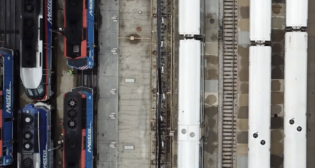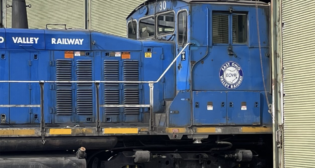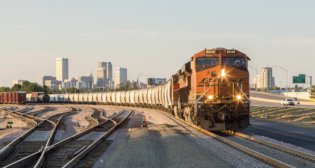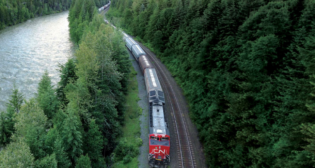
Can STB Pivot to Satisfy Shippers?
Written by Frank N. Wilner, Capitol Hill Contributing EditorWATCHING WASHINGTON, RAILWAY AGE FEBRUARY 2024 ISSUE: Rail captive shippers—primarily of chemicals and coal—unable to utilize barge or truck alternatives and lacking two-railroad competition owing to decades of mergers are an unhappy lot. They pay more because they lack modal choices. “They may be destined to future unhappiness if public policy focus does not change,” says retired University of Tennessee economist Mark Burton.

Public policy can erase discriminatory rate spreads, but decades of such rigid fiat brought the rail industry to the brink of financial ruin. Redemption was delivered by Congress in 1980 through partial economic deregulation—lawmakers recognizing the essentiality of demand-based differential pricing whereby those with fewer transportation alternatives necessarily pay more to keep the rail network solvent.
The economic rationale is railroads have relatively high fixed costs to be paid in full regardless of whether 100,000 carloads are transported or just 1,000. The costs include building and maintaining—and paying property taxes on—an extensive privately owned infrastructure. Barge and truck operators can charge less because their rights-of-way are government provided, with lower than full-cost recovery user charges.
As shippers with competitive options won’t pay more for rail, railroads must charge less if the business is to be had. So long as lower rates at least cover direct costs of the transportation provided—crew compensation, fuel and maintenance associated with infrastructure wear and tear—even a minimal contribution to fixed costs reduces the spread captive shippers must shoulder.
Captives cease to be content when they sense the premiums they pay above direct costs exceed what is sufficient to keep the railroad solvent.
In 1985, Surface Transportation Board (STB) predecessor Interstate Commerce Commission (ICC) ruled discriminatory pricing should cease when railroads reach revenue adequacy—earning enough to maintain the rail system and attract renewal capital.
By merging, reducing headcount and aggressively using demand-based differential pricing, railroads reversed their pre-1980 financial decline. STB Chairperson Martin J. Oberman cites a return to investors, through dividends and share buybacks, of $253 billion over the past 14 years. It is impractical for railroads to argue they are not revenue-adequate.
Yet for more than two generations, efforts by the ICC and STB to develop a methodology protecting captive shippers from market-power abuse have foundered. Intentions aren’t assurances of outcomes.
An early regulatory prescription marking-up fully allocated costs by 7% was invalidated by courts as arbitrary. Others were withdrawn as impractical. A Stand-Alone Cost (SAC) constraint, requiring captives construct on paper a hypothetical most efficient stand-alone railroad tailored to its requirements, is so complex as to cost complainants upward of $5 million. Ridiculously lengthy disputes arise over the number of imaginary restroom stalls and quality of switchyard lighting.
Shippers have largely ceased filing rate complaints—unwilling to commit additional funds for outcomes viewed as primarily in the railroads’ favor. Even simplified SAC alternatives, said to cost under $1 million, are shunned by shippers.
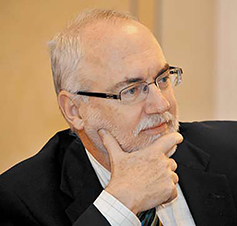
The economist to whom the genesis of SAC is traced, Gerald R. Faulhaber, testified, “There are several possible right answers to how to test for rate reasonableness, but the current SAC model is without doubt the wrong answer.” Department of Justice Antitrust Division economist Russell Pittman, speaking for himself only, says “there appears to be a growing consensus that the SAC test should be replaced. But by what?”
TRB’s Suggestion
A congressionally ordered Transportation Research Board study, concluding all methods attempted by the STB “have proved to be slow, costly and inappropriate to many shippers,” suggested detecting pricing outliers, comparing them to the same commodity traveling a comparable distance, then limiting how much the outlier price may exceed the average price.
STB Staff Recommendation
An STB Rate Reform Task Force recommended a rate-of-return analysis focusing on specific assets used by the railroad serving the captive shipper; or a winner-take-all arbitration process—Final Offer Rate Review—with the STB choosing. Railroads have asked a federal court to require the STB continue its “traditional” rate regulatory process.
Were public policy to pivot toward private sector solutions as advocated by economists Murray Rothbard and David D. Friedman, railroads and shippers would empanel experts who would jointly add a panel of neutral economists—the three panels collectively deciding grievances. Jointly chosen neutral arbitrators would break ties. Costs would be borne by railroads and shippers.
Mandated Reciprocal Switching
Two-railroad competition—lost through decades of mergers—could be restored through mandated “reciprocal switching.” A railroad with sole physical access to a shipper facility would interchange that shipper’s cars, for a regulated fee, to or from a near-by second railroad that would bid for the long-haul.
Will duopolists compete? CSX CEO Joe Hinrichs was quoted, “There is a notion in this industry that somehow we all compete with each other, when actually we mostly partner with each other.”
Still, an academic study found BNSF and Union Pacific competing for Powder River Basin coal shipments—but during a period before all rail rates began rising in 2002. Then, there is Canada, where unfettered open access is accepted by railroads—so much so that when Canadian Pacific made its unsuccessful bid to acquire Norfolk Southern in 2015, it volunteered system-wide open access as a condition. Yet the Association of American Railroads opposes access mandates.
Strikingly, and without explanation, the STB recently cancelled a pending rulemaking mandating reciprocal switching as a means of moderating captive shipper rate increases. It substituted a proposal that access be mandated only if a railroad’s service level falls below a level based on average performance seen during the 2022 supply chain crisis.
Unbundling Rates
The STB could reverse its 1996 ruling that a railroad need only offer a rate on the route the railroad deems most efficient. The STB instead could rule that failure to unbundle and quote separate bottleneck and line-haul segments is an unreasonable practice. Shippers could then challenge the bottleneck rate.
Dr. Pittman’s Suggestion
The STB could determine commodity-specific mark-ups over variable costs based on the STB’s Uniform Rail Costing System (URCS). Yes, it is an outdated and flawed accounting allocation method. Many elements date to 1907 and it has built-in averages from when railroads owned most freight cars and line hauls were shorter. But it is used daily as part of the STB’s regulatory tool kit. “The perfect should not be an enemy of the good,” Pittman says, echoing Nobel-laureate Robert Solow on the sin of “over-refinement.”
Another Pittman approach requires antitrust law changes. If it is determined railroads refuse to compete, “eliminating the railroads’ partial antitrust exemption may indeed improve situations facing some captive shippers and increase overall economic welfare,” he says.
Congress also could allow the STB or shippers to bring complaints against railroads for “refusal to deal” to gain reciprocal switching or rate unbundling. Simply threat of a lawsuit could spur lower rates. Where the Supreme Court once frowned on such cases, it ruled in 2000 that, “under certain circumstances,” refusal to deal can be a tort.
Rank-Order Rate Caps
Another STB prod could be through its annual Revenue Adequacy Shortfall Methodology, which estimates the amount of revenue a railroad requires from traffic moving above 180% of variable costs—a statutory threshold for bringing a rate complaint.
Depending on overall revenue need, the STB could reduce rates incrementally on the highest rated traffic—a laddered approach—until it has exhausted the overage. Initially, all traffic moving at a revenue to variable cost (R/VC) ratio of 500 might be reduced to 450—then, if necessary, to 425 or 400. The calculation would be performed annually.
“It’s time we created a new, forward thinking set of regulatory goals important to the 21st century,” Burton says.

Railway Age Capitol Hill Contributing Editor Frank N. Wilner was formerly assistant vice president for policy at the Association of American Railroads and an STB chief of staff. HIs new book, Railroads & Economic Regulation, is available from Simmons-Boardman Books at www.transalert.com, 800-228-9670.
